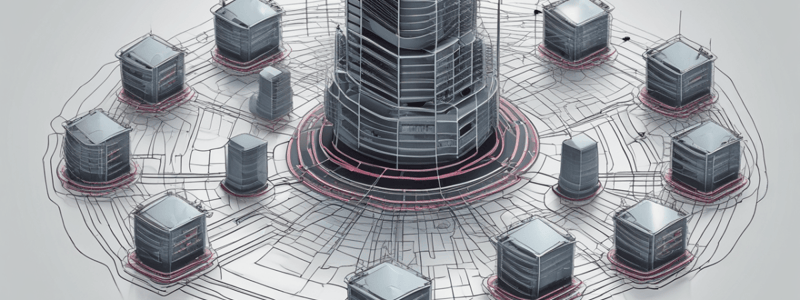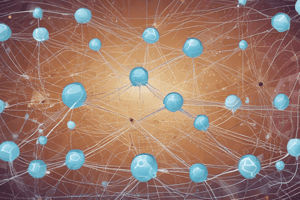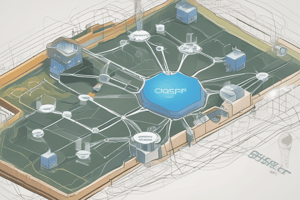Podcast
Questions and Answers
What is the primary reason for electing a DR and BDR on multi-access links in OSPF?
What is the primary reason for electing a DR and BDR on multi-access links in OSPF?
- To reduce CPU utilization on routers
- To reduce redundant LSA flooding (correct)
- To improve network convergence time
- To increase the number of neighbors on a link
What happens when a new router joins a multi-access link and there is no existing DR?
What happens when a new router joins a multi-access link and there is no existing DR?
- The new router becomes a DROTHER
- The new router sends a notification to all other routers on the link
- The new router becomes the BDR
- The new router becomes the DR (correct)
What is the purpose of the router ID in the DR and BDR election process?
What is the purpose of the router ID in the DR and BDR election process?
- To assign a unique name to the router
- To break ties in priority during the election process (correct)
- To determine the IP address of the router
- To determine the priority of the router
What is the role of the DR in synchronizing the link state database?
What is the role of the DR in synchronizing the link state database?
What is the purpose of setting priority numbers in OSPF?
What is the purpose of setting priority numbers in OSPF?
What is the multicast address used by the DR to send routing updates?
What is the multicast address used by the DR to send routing updates?
What happens when a DROTHER has a routing update?
What happens when a DROTHER has a routing update?
What is the role of the BDR in the OSPF routing protocol?
What is the role of the BDR in the OSPF routing protocol?
What is the result of setting a priority number of 0 on an interface?
What is the result of setting a priority number of 0 on an interface?
What is the purpose of the acknowledgement sent by the BDR in the OSPF routing protocol?
What is the purpose of the acknowledgement sent by the BDR in the OSPF routing protocol?
Flashcards are hidden until you start studying
Study Notes
Designated Router (DR) and Backup Designated Router (BDR) Election
- In OSPF, a DR and BDR are elected on multi-access links to reduce redundant LSA flooding.
- Each interface has a priority number (default is 1, can be set to 0-255) and a router ID (unique ID of the router).
- If there is a tie in priority, the router ID breaks the tie.
DR and BDR Election Process
- When a router joins a multi-access link, it sends out hello packets with its router ID, priority number, and empty DR and BDR IP addresses.
- If there is no DR, the router becomes the DR.
- If there is a DR, the new router becomes a DROTHER (other routers on the link).
- If there is a tie in priority, the router ID breaks the tie.
DR and BDR Roles
- The DR is responsible for synchronizing the link state database with all routers on the link.
- The BDR is the backup to the DR and takes over if the DR fails.
- DROTHERs do not synchronize their link state database with each other.
OSPF Priority Numbers
- Priority numbers can be set manually to influence the DR and BDR election.
- A priority number of 0 means the interface will never become the DR or BDR.
- Setting priority numbers allows for deterministic DR and BDR election.
Routing Updates on Multi-Access Links
- The DR sends routing updates to the all OSPF routers multicast address (224.0.0.5).
- The BDR sends an acknowledgement to the all OSPF routers multicast address.
- DROTHERs send an acknowledgement to the DR and BDR multicast address (224.0.0.6).
Sequence of Events for Routing Updates
- DR has an update: sends update to 224.0.0.5, BDR sends acknowledgement to 224.0.0.5, DROTHERs send acknowledgement to 224.0.0.6.
- BDR has an update: sends update to 224.0.0.5, DR sends acknowledgement to 224.0.0.5, DROTHERs send acknowledgement to 224.0.0.6.
- DROTHER has an update: sends update to 224.0.0.6, DR forwards update to 224.0.0.5, BDR sends acknowledgement to 224.0.0.5, DROTHERs send acknowledgement to 224.0.0.6.
Designated Router (DR) and Backup Designated Router (BDR) Election
- In OSPF, DR and BDR are elected on multi-access links to reduce redundant LSA flooding.
- Each interface has a priority number (default is 1, can be set to 0-255) and a router ID (unique ID of the router).
- If there is a tie in priority, the router ID breaks the tie.
DR and BDR Election Process
- When a router joins a multi-access link, it sends out hello packets with its router ID, priority number, and empty DR and BDR IP addresses.
- If there is no DR, the router becomes the DR.
- If there is a DR, the new router becomes a DROTHER (other routers on the link).
- If there is a tie in priority, the router ID breaks the tie.
DR and BDR Roles
- The DR is responsible for synchronizing the link state database with all routers on the link.
- The BDR is the backup to the DR and takes over if the DR fails.
- DROTHERs do not synchronize their link state database with each other.
OSPF Priority Numbers
- Priority numbers can be set manually to influence the DR and BDR election.
- A priority number of 0 means the interface will never become the DR or BDR.
- Setting priority numbers allows for deterministic DR and BDR election.
Routing Updates on Multi-Access Links
- The DR sends routing updates to the all OSPF routers multicast address (224.0.0.5).
- The BDR sends an acknowledgement to the all OSPF routers multicast address.
- DROTHERs send an acknowledgement to the DR and BDR multicast address (224.0.0.6).
Sequence of Events for Routing Updates
- DR has an update: sends update to 224.0.0.5, BDR sends acknowledgement to 224.0.0.5, DROTHERs send acknowledgement to 224.0.0.6.
- BDR has an update: sends update to 224.0.0.5, DR sends acknowledgement to 224.0.0.5, DROTHERs send acknowledgement to 224.0.0.6.
- DROTHER has an update: sends update to 224.0.0.6, DR forwards update to 224.0.0.5, BDR sends acknowledgement to 224.0.0.5, DROTHERs send acknowledgement to 224.0.0.6.
Studying That Suits You
Use AI to generate personalized quizzes and flashcards to suit your learning preferences.




